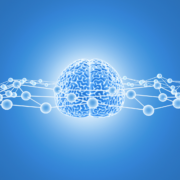What is autism?
April is Autism Acceptance Month—a time to raise awareness about the condition and celebrate individuals with autism.
Autism is a spectrum disorder, which means that the disability is on a continuum and while certain features are shared, they fall along a spectrum and manifest in markedly different forms. These features encompass three key areas: language and communication, socialization, and sensory processing. Some individuals struggle to communicate, while others might have a tough time socializing, thinking, physically moving, or just going about daily living. Still others have challenges processing sensory inputs.
Because autism is so varied, autism experts think of it as multifaceted. Dr. Daniel Geschwind, the Gordon and Virginia Macdonald distinguished professor of human genetics, neurology, and psychiatry at UCLA, refers to autism as “the autisms.”
“It’s not one thing,” Dr. Geschwind said. “Even though they may share basic features, no two autistic children or adults are exactly alike.”
How prevalent is autism? The most recent statistics from the U.S. Centers for Disease Control and Prevention (CDC) came out in March 2023, pulled data from 11 sites (in the United States), and reported 1 out of every 36 children has been classified as having autism. The study before that estimated an autism rate of around 1 in 40. About 10 years ago, the autism rate was 1 in 100 or even lower. In the 1990s, it was around 1 in 1,000. (It wasn’t until 1980 that autism was officially recognized in the Diagnostic and Statistical Manual of Mental Disorders.)
It would be easy to look at this trend and say that autism is increasing. Researchers aren’t certain that’s really what’s happening. According to Dr. Geschwind, the most recent data reflects that the ability to recognize autism and diagnose it early has improved dramatically. “We’re now able to diagnose people with autism who might have (previously) fallen through the cracks,” he said.
Curiously, there appears to be a difference in the rate at which autism has been diagnosed in boys versus girls. In 2012, the CDC estimated that boys were 4.7 times as likely as girls to receive an autism diagnosis. By 2018, the ratio had dipped to 4.2 to 1. And in data released by the CDC in 2023, the figure was 3.8 to 1.
According to The New York Times, that latest analysis was based on the health and education records of more than 226,000 8-year-olds across the country. In it, the autism rate in girls surpassed 1 percent, the highest ever recorded.
One of the potential explanations for this discrepancy is bias in the system. For years, most of the case studies in autism research focused strictly on boys and men. Only recently have researchers begun incorporating more diverse patient groups (read: groups with girls and women) into their studies.
It’s important to note that there is no cure for autism, and that many individuals with autism find the notion of a cure to be offensive, since they consider it to be a neurotype.
Causes of autism
Experts aren’t exactly sure what causes autism. It has been suggested that there is a heritable component to this neurodevelopmental disorder; it is estimated at least 50 percent of genetic risk is predicted by common genetic variation, and another 15 to 20 percent is due to spontaneous mutations or predictable inheritance patterns. Recent research co-authored by Dr. Geschwind identified seven potential genes that were predicted to increase the risk of autism.
All told, one large study suggested that heritable genetic factors are probably somewhere around 80 percent or slightly higher. However, this data suggests that about 20 percent of cases of autism are caused by factors that are nonheritable. Dr. Geschwind said at least 10 percent of autism is caused by rare mutations that are not inherited.
According to Dr. Michael Chez, a pediatric neurologist at the Sutter Institute for Medical Research in Sacramento, California, there is a certain degree of overlap between autism and epilepsy, suggesting that on some level there could be a connection between the two. Other common “comorbidities” with autism are Attention Deficit/Hyperactivity Disorder (ADHD) and bipolar disorder.
“The organization of the brain in the frontal lobe seems to be critically important to the social and reciprocal nature of autism,” said Dr. Chez. “More research needs to be done as to how we can maybe early on affect that organization or maybe stimulate new connectivity to overcome some of those bad connections that are made.”
There also are several environmental factors that act prenatally and have been suggested to increase the risk of autism.
No. 1 on the list: maternal exposure to valproate, an anti-epilepsy medication. There also are several maternal viral infections that have been associated with autism. The interbirth interval can have an impact—that is, how quickly after one birth a mother has another. A fourth potential factor: the age of the father, which could lead to more frequent mutations in sperm.
While mainstream media has quoted influential people who have promoted vaccines as a causal agent for the increase in autism, there is no scientific evidence in support of this theory—and, in fact, research soundly disproves it.
How to treat autism
Because no two autisms are alike and because the extent to which an individual is impacted by their autism can vary widely—there is no agreed upon best practice means of treating autism.
Currently most treatments fall into two categories: behavioral and pharmacological.
Pharmacological treatments are designed to control symptoms; for individuals with autism who have dramatic mood swings and behavioral issues such as irritability, atypical antipsychotic agents such as Aripiprazole or Lurasidone and antidepressant medications can pave the way for more even-keeled behavior. Additionally, there are many novel agents currently under investigation with early reported encouraging results.
In many cases, behavioral treatments are designed to help individuals with autism move away from maladaptive behaviors and embrace new sets of skills to use when they are feeling dysregulated. Therapies such as Applied Behavioral Analysis (ABA) have been used to reinforce new skills in people with autism and to reduce “problematic” behaviors. Within the autism community, however, there is some controversy surrounding ABA—some individuals with autism feel it is used to “normalize” behaviors rather than emphasizing acceptance of autism as an alternative neurodevelopmental approach to life.
Dr. Chez said he advocates for interventions that combine medical and behavioral therapy.
“People will try ABA before they’ll try medicine because they’re afraid of medicine, and I always say, ‘If your kid had asthma or they had diabetes, would you try some other therapy first or would you actually try to give the treatment that might help that condition?’” he said. “I think with autism we have to be open to both.”
Whatever treatment a family chooses, it is imperative to have an early diagnosis, since the data supports early identification and early intervention with behavioral therapies can be effective in up to 50 percent of kids.
This article has been factchecked. For more about that process, click here.









